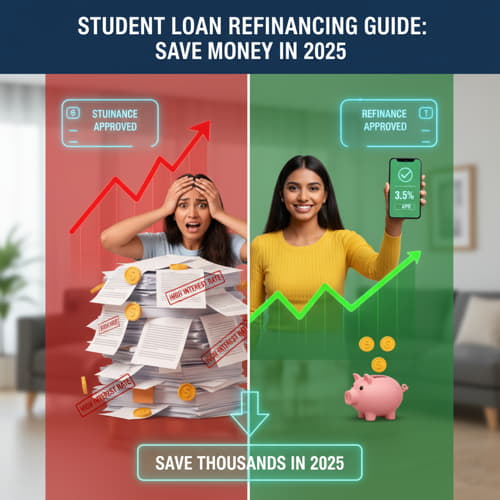Student Loan Refinancing Guide: Save Money in 2025
Student Loan Refinancing Guide: Save Money in 2025
 Introduction
Introduction
Student loans are a reality for millions of graduates around the world. While these loans provide the opportunity to pursue higher education, they often leave students burdened with debt for many years. Fortunately, student loan refinancing offers a way to manage this debt more effectively, potentially saving thousands of dollars over the lifetime of the loan.
In this comprehensive guide, we’ll explain what student loan refinancing is, how it works, who qualifies, and how to get the best deal in 2025.
What is Student Loan Refinancing?
Student loan refinancing means taking out a new loan from a private lender to pay off one or more existing student loans. The goal is to replace your old loan(s) with a new one that has better terms, such as:
Lower interest rate
Reduced monthly payment
Shorter or longer repayment term
Flexible repayment options
This is not the same as student loan consolidation, which only combines multiple federal loans into one payment without lowering the interest rate. Refinancing, on the other hand, can reduce the cost of borrowing.
Benefits of Student Loan Refinancing
Lower Interest Rates
If your credit score has improved since you first borrowed, refinancing could qualify you for much lower rates. For example:Old loan interest rate: 7%
Refinanced loan interest rate: 4%
Over 10 years, this difference could save you thousands of dollars.
Lower Monthly Payments
Extending your loan term can reduce your monthly burden, making it easier to manage finances.Simplified Repayment
If you have multiple loans, refinancing combines them into one loan with a single monthly payment.Flexibility
Many lenders offer flexible repayment options and even allow co-signers to be released after consistent on-time payments.Potential Savings
Borrowers often save $10,000 or more over the life of their loan by refinancing at the right time.
Drawbacks of Student Loan Refinancing
Loss of Federal Benefits
Refinancing federal student loans into a private loan means losing access to federal protections like:Income-driven repayment (IDR) plans
Loan forgiveness programs
Deferment and forbearance options
Credit & Income Requirements
Refinancing is not for everyone. You usually need:A good credit score (670+)
A stable income
Low debt-to-income ratio
Risk of Higher Costs
If you extend your loan term too long, you might pay more interest overall despite a lower rate.
Who Should Consider Refinancing?
Refinancing might be right for you if:
You have private student loans with high interest rates.
Your credit score has improved since borrowing.
You have a stable income and strong employment history.
You don’t need access to federal loan benefits.
You want to simplify multiple loans into one.
Steps to Refinance Student Loans
Check Your Credit Score
Most lenders require a score of at least 670, though the best rates often go to borrowers with scores above 720.Compare Lenders
Shop around with banks, credit unions, and online lenders. Look for:Lowest interest rates
No hidden fees
Flexible repayment terms
Get Prequalified
Many lenders allow you to check estimated rates without a hard credit inquiry.Choose Loan Terms
Decide between:Shorter terms (5 years): Higher monthly payments but big interest savings.
Longer terms (15–20 years): Lower monthly payments but more total interest.
Apply with Required Documents
You’ll need:Loan payoff statements
Proof of income
Credit history
Approval & Payoff
Once approved, your new lender pays off your old loans. You then start making payments on the refinanced loan.
Example of Refinancing Savings
Let’s say you have:
Loan balance: $50,000
Current interest rate: 7%
Term: 10 years
Monthly payment: $580
Total repayment: $69,600
After refinancing:
New interest rate: 4%
Term: 10 years
Monthly payment: $506
Total repayment: $60,720
Savings: $8,880
Tips to Get the Best Refinancing Deal
Improve Your Credit: Pay bills on time and reduce debt before applying.
Use a Co-Signer: If your credit is weak, a co-signer can help secure better terms.
Choose Fixed Rates if Unsure: Variable rates can rise, costing more in the long run.
Avoid Extending Too Long: Unless necessary, don’t pick very long terms, as interest costs pile up.
Refinance Again: You can refinance multiple times if better rates appear in the future.
Mistakes to Avoid
Refinancing federal loans without understanding the loss of forgiveness benefits.
Accepting the first lender’s offer without comparing.
Choosing the lowest monthly payment without considering the total interest.
Ignoring fees, penalties, or prepayment restrictions.
Final Thoughts
Student loan refinancing can be a smart financial decision in 2025 if you meet the eligibility requirements and no longer need federal protections. By shopping around, improving your credit, and carefully choosing loan terms, you can significantly reduce your interest payments and pay off debt faster.
Remember: refinancing isn’t right for everyone. If you rely on income-driven repayment or forgiveness programs, you should avoid it. But if your main goal is to save money, refinancing is one of the most effective tools available.
 Introduction
Introduction

